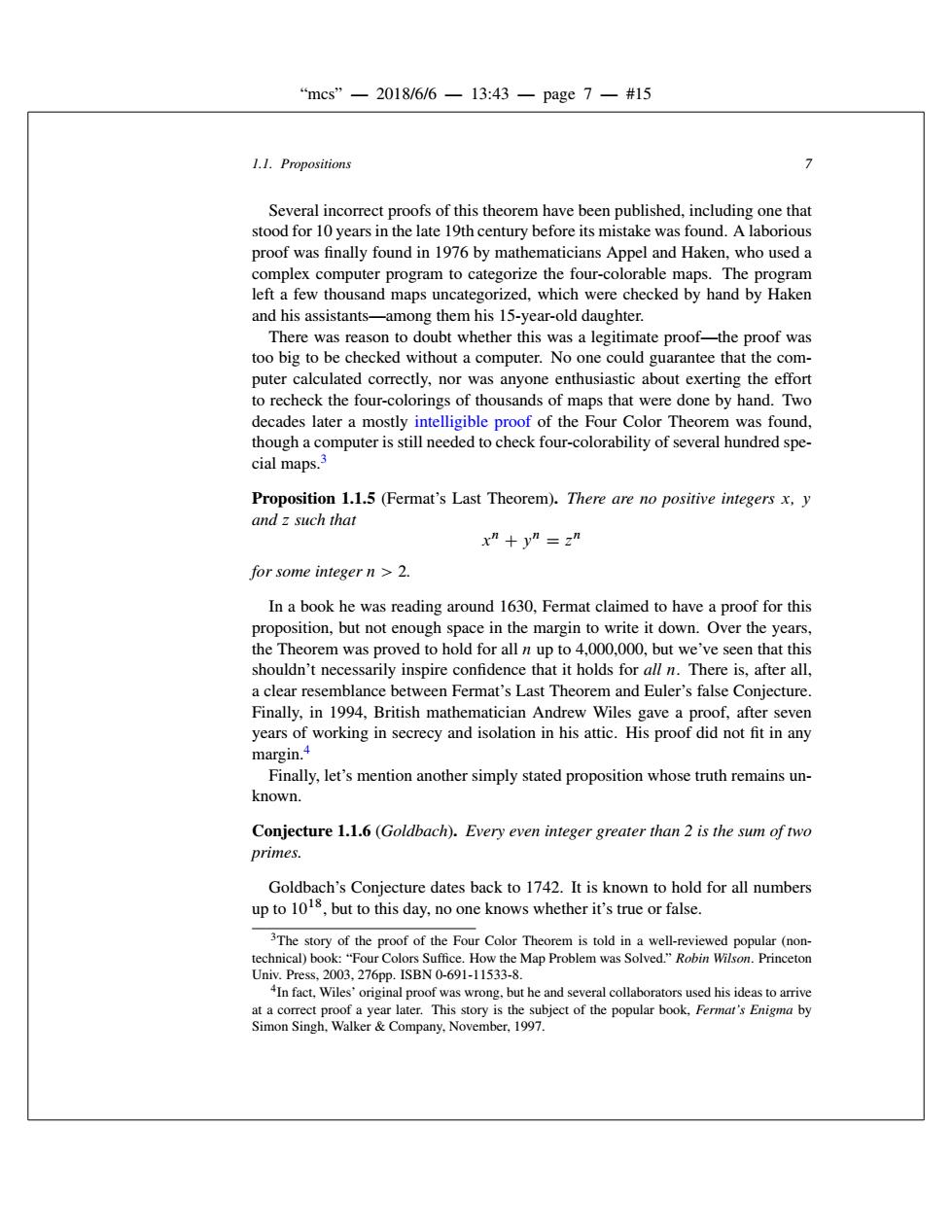正在加载图片...

“mcs”-2018/6/6一13:43一page7-#15 1.1.Propositions Several incorrect proofs of this theorem have been published,including one that stood for 10 years in the late 19th century before its mistake was found.A laborious proof was finally found in 1976 by mathematicians Appel and Haken,who used a complex computer program to categorize the four-colorable maps.The program left a few thousand maps uncategorized,which were checked by hand by Haken and his assistants-among them his 15-year-old daughter. There was reason to doubt whether this was a legitimate proof-the proof was too big to be checked without a computer.No one could guarantee that the com- puter calculated correctly,nor was anyone enthusiastic about exerting the effort to recheck the four-colorings of thousands of maps that were done by hand.Two decades later a mostly intelligible proof of the Four Color Theorem was found, though a computer is still needed to check four-colorability of several hundred spe- cial maps.3 Proposition 1.1.5 (Fermat's Last Theorem).There are no positive integers x,y and z such that x”+yn=zm for some integer n >2. In a book he was reading around 1630,Fermat claimed to have a proof for this proposition,but not enough space in the margin to write it down.Over the years, the Theorem was proved to hold for all n up to 4,000,000,but we've seen that this shouldn't necessarily inspire confidence that it holds for all n.There is,after all, a clear resemblance between Fermat's Last Theorem and Euler's false Conjecture. Finally,in 1994,British mathematician Andrew Wiles gave a proof,after seven years of working in secrecy and isolation in his attic.His proof did not fit in any margin.4 Finally,let's mention another simply stated proposition whose truth remains un- known. Conjecture 1.1.6 (Goldbach).Every even integer greater than 2 is the sum of two primes. Goldbach's Conjecture dates back to 1742.It is known to hold for all numbers up to 1018,but to this day,no one knows whether it's true or false. 3The story of the proof of the Four Color Theorem is told in a well-reviewed popular(non- technical)book:"Four Colors Suffice.How the Map Problem was Solved."Robin Wilson.Princeton Univ.Press,2003,276pp.ISBN0-691-11533-8. 4In fact,Wiles'original proof was wrong.but he and several collaborators used his ideas to arrive at a correct proof a year later.This story is the subject of the popular book,Fermat's Enigma by Simon Singh,Walker Company.November,1997.“mcs” — 2018/6/6 — 13:43 — page 7 — #15 1.1. Propositions 7 Several incorrect proofs of this theorem have been published, including one that stood for 10 years in the late 19th century before its mistake was found. A laborious proof was finally found in 1976 by mathematicians Appel and Haken, who used a complex computer program to categorize the four-colorable maps. The program left a few thousand maps uncategorized, which were checked by hand by Haken and his assistants—among them his 15-year-old daughter. There was reason to doubt whether this was a legitimate proof—the proof was too big to be checked without a computer. No one could guarantee that the computer calculated correctly, nor was anyone enthusiastic about exerting the effort to recheck the four-colorings of thousands of maps that were done by hand. Two decades later a mostly intelligible proof of the Four Color Theorem was found, though a computer is still needed to check four-colorability of several hundred special maps.3 Proposition 1.1.5 (Fermat’s Last Theorem). There are no positive integers x, y and z such that x n C y n D z n for some integer n > 2. In a book he was reading around 1630, Fermat claimed to have a proof for this proposition, but not enough space in the margin to write it down. Over the years, the Theorem was proved to hold for all n up to 4,000,000, but we’ve seen that this shouldn’t necessarily inspire confidence that it holds for all n. There is, after all, a clear resemblance between Fermat’s Last Theorem and Euler’s false Conjecture. Finally, in 1994, British mathematician Andrew Wiles gave a proof, after seven years of working in secrecy and isolation in his attic. His proof did not fit in any margin.4 Finally, let’s mention another simply stated proposition whose truth remains unknown. Conjecture 1.1.6 (Goldbach). Every even integer greater than 2 is the sum of two primes. Goldbach’s Conjecture dates back to 1742. It is known to hold for all numbers up to 1018, but to this day, no one knows whether it’s true or false. 3The story of the proof of the Four Color Theorem is told in a well-reviewed popular (nontechnical) book: “Four Colors Suffice. How the Map Problem was Solved.” Robin Wilson. Princeton Univ. Press, 2003, 276pp. ISBN 0-691-11533-8. 4 In fact, Wiles’ original proof was wrong, but he and several collaborators used his ideas to arrive at a correct proof a year later. This story is the subject of the popular book, Fermat’s Enigma by Simon Singh, Walker & Company, November, 1997